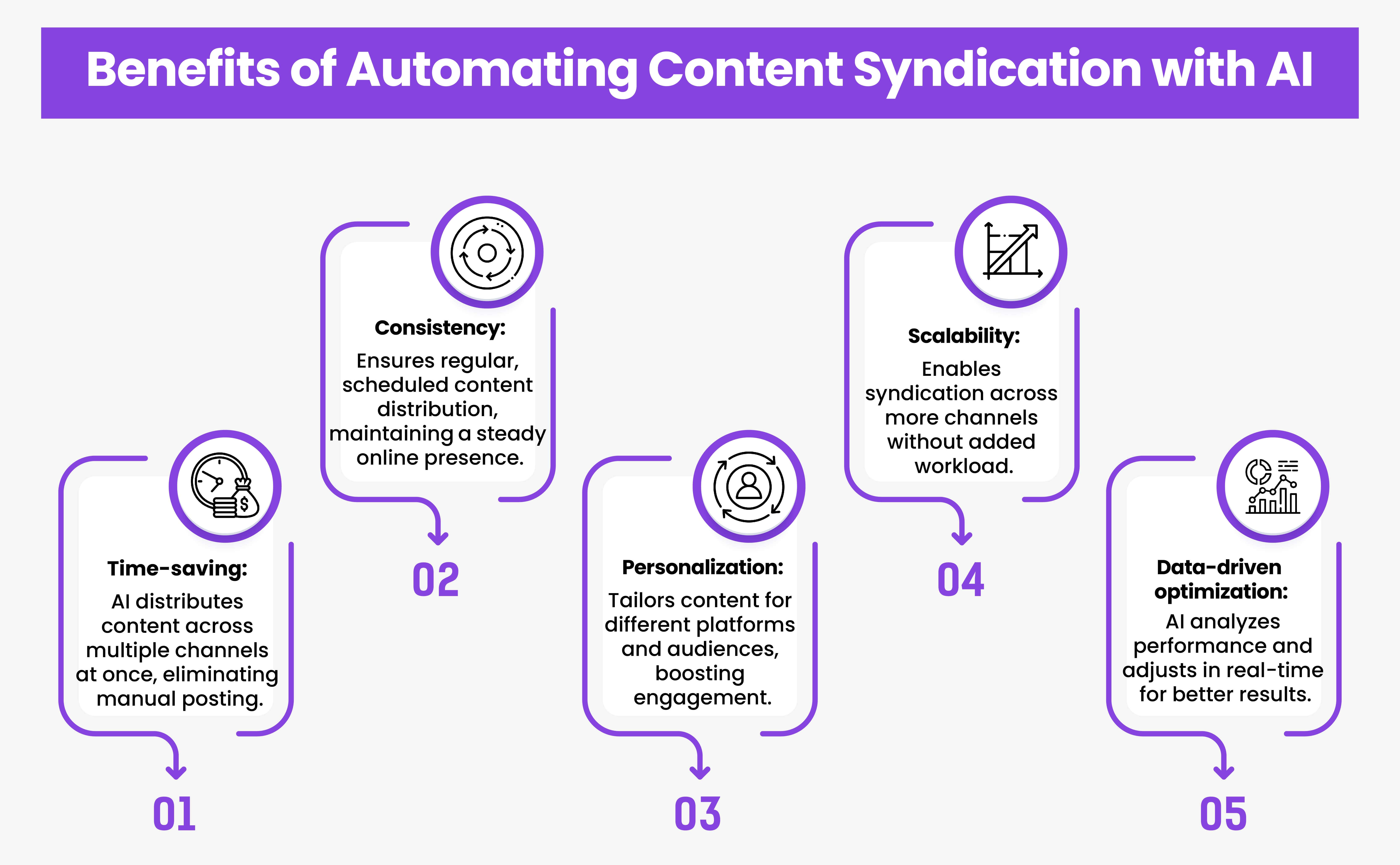Yes, content syndication is transformative. It’s no longer a mere tool for mass distribution, it’s becoming a sophisticated way to target specific audiences, all while leveraging the latest in AI and data-driven strategies.
Willing or not, it may become your best friend in era of shifting B2B landscape.
As the industry adapts to new technologies and shifting buyer behaviors, the future of content syndication holds immense potential for growth and innovation.
Let’s embark on this journey together.
Future Trends in B2B Content Syndication
A New Era for Content Syndication in B2B Marketing
Content syndication is no longer about plastering your message across the internet. We’re entering an era. Where quality trumps quantity, where precision is paramount.
Traditionally, syndication was about casting a wide net. Today, it’s about strategically placing content in front of the right people at the right time.
Account-Based Syndication (ABS):
Inspired by Account-Based Marketing (ABM), ABS focuses on targeting high-value accounts, delivering highly personalized content to key decision-makers.
Quality Over Quantity:
Content saturation is real. Today’s buyers want relevance, not noise. Content syndication strategies that emphasize high-quality, tailored content will stand out from the rest.
Must Read: 5 Critical B2B Content Syndication Mistakes Marketers Should Avoid!
Key Trends Shaping the Future
Several powerful trends are set to redefine the way B2B companies approach content syndication:
Intent-Driven Syndication:
Using intent data, companies can now push content to prospects who are already searching for solutions like theirs. With this you ensure your content reaches prospects who are further along the buyer’s journey, increasing the likelihood of conversions.
AI-Powered Distribution:
AI isn’t just for automation; it’s for optimizing. By analyzing vast amounts of user data, AI can pinpoint when and where your content should be delivered for maximum impact.
Interactive Content:
The days of static content are over. Webinars, quizzes, and interactive infographics are becoming essential for grabbing attention and boosting engagement.
Multi-Channel Approach:
With more networks than ever—social media, email, publications—companies need to distribute their content across multiple platforms to ensure maximum reach and engagement.
Innovations in Syndication Technology
As marketing technology evolves, so do the tools available for content syndication. Here are a few innovations reshaping the landscape:
AI-Poweredic Syndication:
Automated platforms allow marketers to syndicate at scale while maintaining precision. Programmatic content distribution is efficient and effective.
Hyper-Personalization:
Advances in data analytics mean content can now be hyper-personalized, tailored to individual users based on their preferences, behaviors, and intent.
AI’s Transformative Role in B2B Content Syndication
AI has transformed nearly every aspect of marketing, and content syndication is no exception:
Content Discovery:
AI-driven tools help marketers discover and curate content that resonates with specific audiences, making syndication efforts more effective.
Predictive Analytics:
AI can forecast which prospects are most likely to engage, allowing marketers to focus their efforts on high-potential leads.
Optimized Placement:
AI determines the best platforms and times to distribute content, ensuring that it reaches the right audience when they’re most likely to engage.

The Benefits of AI-Driven Syndication
The integration of AI into content syndication offers multiple benefits:
- Efficiency: AI automates much of the distribution process, saving time and ensuring that content is delivered at the optimal moment.
- Enhanced Targeting: By analyzing intent and behavior, AI ensures content is shown to the most relevant audience.
- Personalization: AI enables deeper levels of personalization, allowing marketers to create content experiences that resonate on an individual level.
Must Read: The Top 5 Benefits of B2B Content Syndication
What are Challenges You Need to Consider
Despite the many benefits, AI-powered syndication comes with its own set of challenges:
- Data Privacy: As marketers rely on intent data, they must navigate the complex world of data privacy regulations, such as GDPR.
- Tech Integration: Implementing AI-powered syndication tools can be complex and expensive, requiring seamless integration with existing tech stacks.
- Content Saturation: Automated content distribution can lead to overexposure, making it crucial for marketers to strike the right balance between visibility and relevance.
What are the Best Practices for Success
To get the most out of your content syndication efforts, here are a few best practices to keep in mind:
- Leverage Intent Data: Use intent data to syndicate content to prospects who are already showing interest in your solution.
- Adopt AI-Driven Tools: Invest in tools that use AI to automate and optimize your syndication efforts.
- Diversify Distribution: Don’t rely on one platform. Distribute your content across multiple platforms to reach your audience wherever they are.
- Measure and Optimize: Track performance metrics and continually refine your strategy to ensure maximum engagement and ROI.
What the Future Holds
As we look toward the future, here’s what we can expect from content syndication:
- Deeper ABM Integration: Syndication will become even more closely aligned with account-based marketing, leading to more personalized content experiences.
- Rise of Voice and Video: As voice search and video content syndication continue to grow, expect to see these formats playing a bigger role in syndication strategies.
- Blockchain for Transparency: Blockchain technology could provide new levels of transparency and security in content syndication, ensuring accuracy and attribution.
Conclusion
The future of B2B content syndication is bright. AI and data-driven strategies will continue to drive innovation, helping businesses engage with high-value prospects and achieve measurable growth.
Now is the time to dive into content syndication and gain a competitive edge. By staying ahead of these trends and adopting cutting-edge tools, marketers can ensure that their syndication efforts remain effective, relevant, and impactful.
Frequently Asked Questions (FAQs)
How is B2B content syndication evolving?
B2B content syndication is moving from mass distribution to precise targeting. It’s now driven by intent data, AI-powered delivery, and personalized content experiences. The focus is on quality over quantity—ensuring content reaches the right person at the right time.
What is Account-Based Syndication (ABS)?
Account-Based Syndication (ABS) is a hyper-targeted approach inspired by Account-Based Marketing (ABM). It syndicates content specifically to high-value accounts and decision-makers within them, using personalization and intent data to increase engagement and conversions.
What role does AI play in modern content syndication?
AI transforms content syndication by:
- Analyzing behavior and intent signals
- Predicting the best time and channel to deliver content
- Automating distribution across multiple platforms
- Improving targeting accuracy and engagement rates
It allows marketers to scale smartly without compromising personalization.
What is intent-driven content syndication?
Intent-driven syndication uses real-time behavioral data to identify prospects who are actively researching relevant topics or solutions. Content is then syndicated to these warm leads, increasing the chances of meaningful engagement and qualified lead generation.
Why is interactive content gaining importance in syndication?
Static content often gets ignored. Interactive formats like webinars, calculators, quizzes, and infographics:
- Drive more engagement
- Keep users on the page longer
- Encourage deeper exploration
These experiences are more memorable and effective in the crowded B2B landscape.
What are the benefits of AI-driven content syndication?
AI-based syndication offers:
- Efficiency: Reduces manual effort by automating tasks
- Precision: Targets the right prospects with data-backed decisions
- Personalization: Delivers tailored content to individual users
- Performance: Improves lead quality and reduces cost-per-lead
What challenges come with AI-powered syndication?
Some key concerns include:
- Data privacy (GDPR, CCPA compliance)
- Integration complexity with existing systems
- Overexposure risk from excessive automation
To overcome these, marketers must balance automation with strategy and remain compliant with regulations.
How does content syndication fit into Account-Based Marketing (ABM)?
In ABM, targeting specific accounts is essential. Content syndication enhances ABM by:
- Distributing personalized content to decision-makers
- Engaging stakeholders across different channels
- Reinforcing brand messaging throughout the buying committee
Future syndication efforts will be even more tightly integrated with ABM strategies.
What formats will dominate future syndication efforts?
Expect to see increased focus on:
- Video content (demos, webinars, short explainers)
- Voice search-optimized articles
- Interactive experiences (ROI calculators, assessments)
These formats align with evolving buyer preferences and mobile-first behaviors.
Could blockchain be used in content syndication?
Yes. Blockchain technology can add transparency, trust, and verification in syndication by:
- Confirming content attribution and origin
- Preventing content tampering
- Creating traceable audit trails for compliance
It’s still an emerging application but holds promising potential for syndicated content ecosystems.




